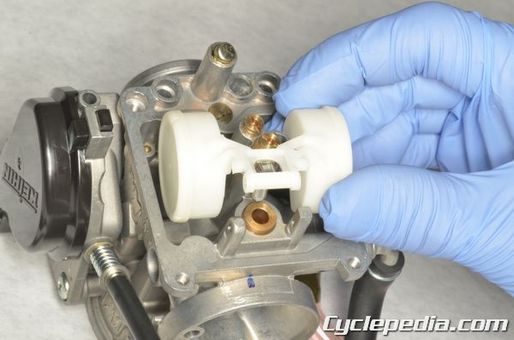A new topic on carburetor float valves has been added to the Cyclepedia.com Common service manual.

The final mechanism of fuel delivery to the carburetor is the float valve. The float valve is a fantastically simple mechanism to regulate fuel needs for the carburetor. Unfortunately, it is often problematic when fuel is left in the carburetor for an extended period of time.
The float valve has three main components: an orifice (seat), a needle, and a float. The needle rides inside the orifice. When the needle is forced all the way in it blocks the orifice and stops fuel from flowing into the float bowl. Fuel can flow into the float bowl when the needle is retracted from the orifice. The movement of the needle is controlled by the float position.
In a dry carburetor the float valve should be open as the floats hang down in the empty float chamber and the needle is retracted from the seat. As fuel fills the float bowl, the float is lifted and moves the float needle further into the seat. Eventually, when the fuel reaches the specified level the needle should be fully seated in the orifice and block additional fuel from entering the float bowl.
The fuel level can become excessive if the float valve sticks open, cannot seal, or opens too much. This can cause a rich condition and fouled plugs while the engine is running. When the engine is not running, fuel will continue to poor into the carburetor. The fuel level will rise until it finds its way out a vent, makes its way into the airbox, or empties into the engine.
A faulty float valve can result in a hydro locked engine if enough fuel makes its way inside the cylinder and/or leaks into the crankcase. If gasoline has entered the engine carefully clear the cylinder and change the oil. Oil that smells of gasoline is a sign of gas contamination from a faulty float valve.
If the float valve sticks closed or opens too little the fuel level will be insufficient. This can result is a lean condition while the engine is running. That is if the engine will start and run at all.
For more information and photos on carburetor float valve function and inspection check out the Cyclepedia Common Service Manual.



Leave a Reply
You must be logged in to post a comment.